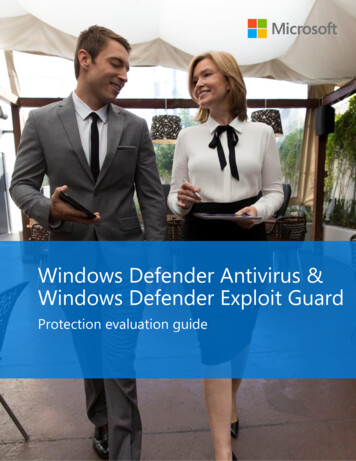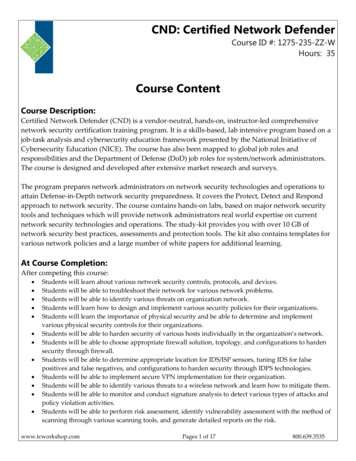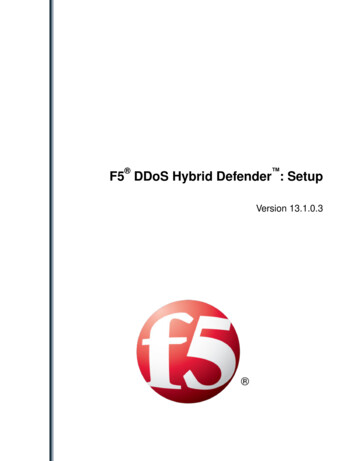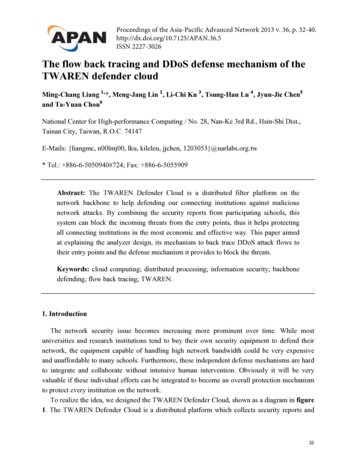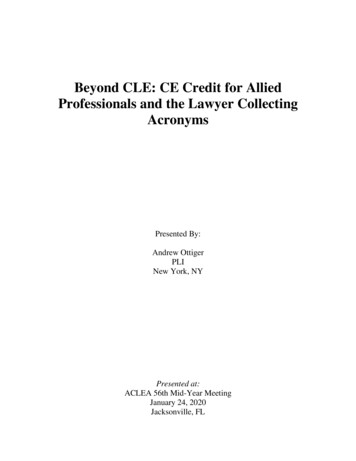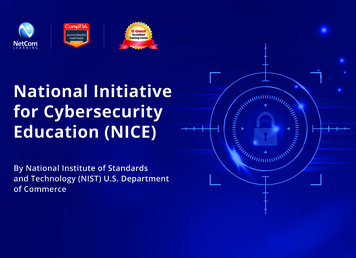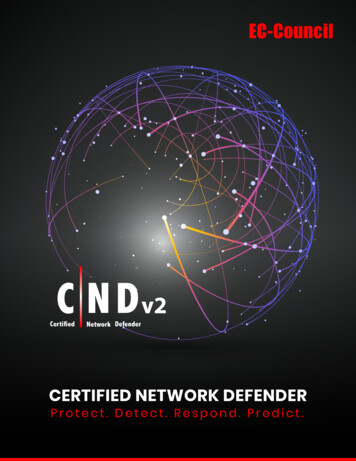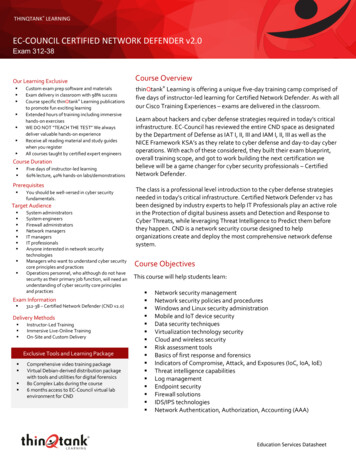
Transcription
THINQTANK LEARNINGEC‐COUNCIL CERTIFIED NETWORK DEFENDER v2.0Exam 312-38Our Learning Exclusive Custom exam prep software and materialsExam delivery in classroom with 98% successCourse specific thinQtank Learning publicationsto promote fun exciting learningExtended hours of training including immersivehands‐on exercisesWE DO NOT “TEACH THE TEST” We alwaysdeliver valuable hands‐on experienceReceive all reading material and study guideswhen you registerAll courses taught by certified expert engineersCourse Duration Five days of instructor‐led learning60% lecture, 40% hands‐on labs/demonstrationsPrerequisites You should be well‐versed in cyber securityfundamentals.Target Audience System administratorsSystem engineersFirewall administratorsNetwork managersIT managersIT professionalsAnyone interested in network securitytechnologiesManagers who want to understand cyber securitycore principles and practicesOperations personnel, who although do not havesecurity as their primary job function, will need anunderstanding of cyber security core principlesand practicesExam Information 312‐38 – Certified Network Defender (CND v2.0)Delivery Methods Instructor‐Led TrainingImmersive Live‐Online TrainingOn‐Site and Custom DeliveryExclusive Tools and Learning Package Comprehensive video training packageVirtual Debian‐derived distribution packagewith tools and utilities for digital forensics80 Complex Labs during the course6 months access to EC‐Council virtual labenvironment for CNDCourse OverviewthinQtank Learning is offering a unique five‐day training camp comprised offive days of instructor‐led learning for Certified Network Defender. As with allour Cisco Training Experiences – exams are delivered in the classroom.Learn about hackers and cyber defense strategies required in today's criticalinfrastructure. EC‐Council has reviewed the entire CND space as designatedby the Department of Defense as IAT I, II, III and IAM I, II, III as well as theNICE Framework KSA’s as they relate to cyber defense and day‐to‐day cyberoperations. With each of these considered, they built their exam blueprint,overall training scope, and got to work building the next certification webelieve will be a game changer for cyber security professionals – CertifiedNetwork Defender.The class is a professional level introduction to the cyber defense strategiesneeded in today's critical infrastructure. Certified Network Defender v2 hasbeen designed by industry experts to help IT Professionals play an active rolein the Protection of digital business assets and Detection and Response toCyber Threats, while leveraging Threat Intelligence to Predict them beforethey happen. CND is a network security course designed to helporganizations create and deploy the most comprehensive network defensesystem.Course ObjectivesThis course will help students learn: Network security managementNetwork security policies and proceduresWindows and Linux security administrationMobile and IoT device securityData security techniquesVirtualization technology securityCloud and wireless securityRisk assessment toolsBasics of first response and forensicsIndicators of Compromise, Attack, and Exposures (IoC, IoA, IoE)Threat intelligence capabilitiesLog managementEndpoint securityFirewall solutionsIDS/IPS technologiesNetwork Authentication, Authorization, Accounting (AAA)Education Services Datasheet
THINQTANK LEARNINGEC‐COUNCIL CERTIFIED NETWORK DEFENDER v2.0Exam 312-38Does it Benefit You?According to LinkedIn’s 2020 Emerging Jobs Report, Network Defender jobs are in high demand. Globally, NetworkAdministrators and Engineers are adding significant value to their jobs and salary by learning critical network security andnetwork defense skills.The following individuals can consider EC‐Council’s Network Security Certifications as the next move in their career: Cisco or Microsoft Certified Network Administrator/EngineersWireshark Certified Network AnalystSolarWinds Certified ProfessionalJuniper Certified Network ProfessionalProfessionals with Comptia’s Network /Security CertificationUniversity professors who are teaching cybersecurity coursesIT professionals planning a career transitionLearners who wish to start a career in cybersecurityIndividuals who complete the CND v2 cybersecurity course qualify for the following entry‐level job roles: Entry‐level Network AdministratorsEntry‐level Network Security AdministratorsData Security AnalystJunior Network Security EngineerJunior Network Defense TechnicianSecurity AnalystSecurity OperatorThe end goal of Certified Network Defender (CND v2) is to help Blue Teams defend and win the war against network breaches.The program is the ideal cyber defense course for organizations and individuals for the following reasons: Based on Common Job Role frameworks recognized by organizations around the world.ANSI/ISO/IEC 17024 accredited Certification Program.Mapped to the NICE 2.0 framework.Focuses on latest technologies including Cloud, IoT, Virtualization and Remote Worker Threats, Attack Surface Analysis,Threat Intelligence, Software Defined Networks (SDN), and Network Function Virtualization (NFV), as well as docker,Kubernetes, and container security.Covers the latest tools, techniques, and methodologies used by top cybersecurity experts around the world.Education Services Datasheet
THINQTANK LEARNINGEC‐COUNCIL CERTIFIED NETWORK DEFENDER v2.0Exam 312-38Build Your CareerYOUR PATHWAY TO A CAREER IN A BLUE TEAM The Protect, Detect, Respond, and Predict approach defines the job roles for a Blue Team Security Professional. Onecan continue their career as a Network Defender or later transition into a niche job profile as CND v2 covers a baseunderstanding of Blue Teams.MOBILE & IOT SECURITY DEFENSE The first certification program to offer device and enterprise level security for its students. Career changers planning amove into cybersecurity will also benefit from this.TACTICAL DEFENSE OF CLOUD SERVICES Learn different ways to ensure security across various cloud platforms — Amazon Web Services, Microsoft AzureCloud, and Google Cloud Platform.LEARNING BEYOND TECHNICAL ASPECTS CND v2 is the only certification program that offers a chance to learn beyond the technological aspects of networksecurity. The module has a strong focus on the strategical domain with special attention to adaptive & defense indepth security, framing network policies, achieving compliance, and the operational domain to learn theimplementation of the above decisions.BUILDING PERIMETER DEFENSE SKILLS CND v2 puts the spotlight on perimeter defense as the latest technologies have made networks too complex foreveryone. Perimeter defense can help with modern security requirements.80 COMPLEX LABS The only program that gives a chance to students to learn under simulated threat environments and gain real‐worldskills before they start their professional career.Education Services Datasheet
THINQTANK LEARNINGEC‐COUNCIL CERTIFIED NETWORK DEFENDER v2.0Exam 312-38Course Modules and Labs Module 01: Network Attacks and DefenseStrategiesModule 02: Administrative Network SecurityModule 03: Technical Network SecurityModule 04: Network Perimeter SecurityModule 05: Endpoint Security‐Windows SystemsModule 06: Endpoint Security‐Linux SystemsModule 07: Endpoint Security‐ Mobile DevicesModule 08: Endpoint Security‐IoT DevicesModule 09: Administrative Application SecurityModule 10: Data SecurityModule 11: Enterprise Virtual Network SecurityModule 12: Enterprise Cloud Network SecurityModule 13: Enterprise Wireless Network SecurityModule 14: Network Traffic Monitoring andAnalysisModule 15: Network Logs Monitoring and AnalysisModule 16: Incident Response and ForensicInvestigationModule 17: Business Continuity and DisasterRecoveryModule 18: Risk Anticipation with RiskManagementModule 19: Threat Assessment with AttackSurface AnalysisModule 20: Threat Prediction with Cyber ThreatIntelligence Exercise 1‐1: Understanding the Workings of SQLInjection Attacks Exercise 1‐2: Understanding the Workings of XSSAttacks Exercise 1‐3: Understanding the Workings of NetworkScanning Attacks Exercise 1‐4: Understanding the Workings of Brute‐Force Attacks Exercise 2‐1: Implementing Password Policies UsingWindows Group Policy Exercise 2‐2: Implementing Password Policies in Linux Exercise 2‐3: Monitoring Activities on a Remote UserSystem Exercise 3‐1: Implementing Just Enough Administrationto Secure Privileged Access Exercise 3‐2: Implementing Role‐Based Access Controlusing Windows Admin Center Exercise 4‐1: Implementing Network‐Based FirewallFunctionality: Blocking Unwanted Website access usingpfSense Firewall Exercise 4‐2: Implementing Network‐Based FirewallFunctionality: Blocking Insecure Ports using pfSenseFirewall Exercise 4‐3: Implementing Network‐Based FirewallFunctionality: Blocking Internal FTP Server AccessUsing Smoothwall FirewallExercise 4‐4: Implementing Host‐ba sed FirewallFunctionality Using Windows FirewallExercise 4‐5: Implementing Host‐based FirewallProtection with iptablesExercise 4‐6: Implementing Network‐based IDSFunctionality Using Suricata IDSExercise 4‐7: Implementing Host‐based IDSfunctionality using Wazuh HIDSExercise 5‐1: Basic Network Administration andTroubleshooting Using Windows Command‐LineUtilitiesExercise 5‐2: Securing Windows File Share in ActiveDirectoryExercise 5‐3: Analyzing Security ConfigurationBaseline Using Microsoft Security ComplianceToolkit in WindowsExercise 5‐4: Remote Patch Management usingBatchPatchExercise 5‐5: Remote Patch Management usingManageEngine Patch Manager PlusExercise 5‐6: Delegating Admin Permission to UserUsing Delegation of Control WizardExercise 5‐7: Securing Local Administrator Passwordusing LAPSExercise 6‐1: Implementing Linux Security BestPracticesExercise 7‐1: Implementing Enterprise MobileSecurity Using Miradore MDM SolutionExercise 8‐1: Securing IoT Device CommunicationUsing TLS/SSLExercise 9‐1: Implementing Application WhitelistingUsing AppLockerExercise 10‐1: Encrypting Data at Rest UsingVeraCryptExercise 10‐2: Implementing Encryption on SQLServer Database using Transparent DatabaseEncryption MethodExercise 10‐3: Implementing Always Encrypted inSQL ServerExercise 10‐4: Encrypting Data in Transit Using SSLExercise 10‐5: Ensuring Secure Email Communicationusing PGPExercise 10‐6: Performing Data Backup Using AOMEIBackupper StandardExercise 10‐7: File Recovery Using EaseUS DataRecovery WizardExercise 10‐8: File Recovery Using Kernel forWindows Data Recovery ToolExercise 10‐9: Partition Recovery Using MiniToolPower Data Recovery ToolEducation Services Datasheet
THINQTANK LEARNINGEC‐COUNCIL CERTIFIED NETWORK DEFENDER v2.0Exam 312-38Course Labs Continued Exercise 11‐1: Auditing Docker Host SecurityUsing Docker‐Bench‐Security ToolExercise 11‐2: Securing SDN CommunicationBetween Switch and SDN Controller Using SSLExercise 12‐1: Implementing Amazon WebServices Identity and Access ManagementExercise 12‐2: Implementing Key ManagementServices in Amazon Web ServicesExercise 12‐3: Securing Amazon Web ServicesStorageExercise 13‐1: Configuring Security on a WirelessRouterExercise 14‐1: Capturing Network Traffic usingWiresharkExercise 14‐2: Analyzing and Examining VariousNetwork Packet Headers using WiresharkExercise 14‐3: Analyzing and Examining VariousNetwork Packet Headers in Linux using tcpdumpExercise 14‐4: Applying Various Filters inWiresharkExercise 14‐5: Detecting Clear‐Text Traffic usingWiresharkExercise 14‐6: Monitoring and Detecting NetworkReconnaissance AttemptsExercise 14‐7: Detecting Brute‐Force AttemptUsing WiresharkExercise 14‐8: Detecting SQL Attack usingWiresharkExercise 14‐9: Network Traffic Monitoring usingPRTGExercise 14‐10: Network Traffic Analysis UsingCapsaExercise 14‐11: Network Traffic BandwidthMonitoring ‐ NTOP in pfSenseExercise 15‐1: Configuring, Viewing, andAnalyzing Windows Event LogsExercise 15‐2: Configuring, Viewing, andAnalyzing IIS LogsExercise 15‐3: Configuring, Viewing, andAnalyzing Logs in a Centralized Location UsingSplunkExercise 15‐4: Identifying Suspicious ActivitiesUsing Log Monitoring and AnalysisExercise 16‐1: Working with Incident Tickets inOSSIM Exercise 17‐1: Implementing Business Continuityand Disaster Recovery Using NLBExercise 18‐1: Vulnerability Management usingOSSIMExercise 18‐2: Vulnerability Analysis Using theNessusExercise 18‐3: Network Vulnerabilities ScanningUsing GFI LanGuardExercise 18‐4: Auditing the Network Security withNsauditorExercise 18‐5: Application Vulnerability Scanningusing OWASP ZAPExercise 19‐1: System Attack Surface Analysisusing Windows Attack Surface AnalyzerExercise 19‐2: Analyzing Web Application AttackSurface using OWASP Attack Surface Detector(ZAP Plugin)Exercise 19‐3: Attack Surface Mapping andVisualizing using AmassExercise 20‐1: Integrating OTX Threat Feeds inOSSIMEducation Services Datasheet
THINQTANK LEARNINGEC‐COUNCIL CERTIFIED NETWORK DEFENDER v2.0Exam 312-38thinQtank Global, Inc. dba thinQtank Learning P.O. Box 803215, Valencia, CA 91380 USATel 855‐TO‐THINQFax 208‐979‐0668www.thinqtanklearning.com 2021 thinQtank Global, Inc. All rights reserved. The product or learning materials are protected by U.S. and intellectual propertylaws. thinQtank Global, thinQtank Learning and the Q‐Man logo are registered trademarks of thinQtank Global, Inc. in the UnitedStates and/or other jurisdictions. All other marks and names mentioned herein may be trademarks of their respective companies.thinQtank Global, Inc. warrants that it will perform these training services in a reasonable manner using generally accepted industry standards andpractices. THE EXPRESS WARRANTY SET FORTH IS IN LIEU OF ALL OTHER WARRANTIES, EXPRESS, IMPLIED, STATUTORY OR OTHERWISE INCLUDINGIMPLIED WARRANTIES OF MERCHANTABILITY OR FITNESS FOR A PARTICULAR PURPOSE WITH RESPECT TO THE SERVICES AND DELIVERABLESPROVIDED BY THINQTANK GLOBAL, INC., OR AS TO THE RESULTS WHICH MAY BE OBTAINED THEREFROM. THINQTANK GLOBAL, INC. WILL NOT BELIABLE FOR ANY THIRD‐PARTY SERVICES OR PRODUCTS IDENTIFIED OR REFERRED TO CUSTOMER. All materials provided in this training arecopyrighted by thinQtank Global, Inc. ("Learning Materials"). thinQtank Global, Inc. grants the customer of this learning a license to use LearningMaterials strictly for the purpose of facilitating such company's internal understanding, utilization and operation of the technology covered herein.Except as set forth expressly in the sentence above, there is no transfer of any intellectual property rights or any other license granted under theterms of this training.Education Services Datasheet
Education Services Datasheet EC‐COUNCIL CERTIFIED NETWORK DEFENDER v2.0 Exam 312-38 THINQTANK LEARNING thinQtank Global, Inc. dba thinQtank Learning P.O. Box 803215, Valencia, CA 91380 USA Tel 855‐TO‐THINQ Fax 208‐979‐0668 www.thinqtanklearning.com
